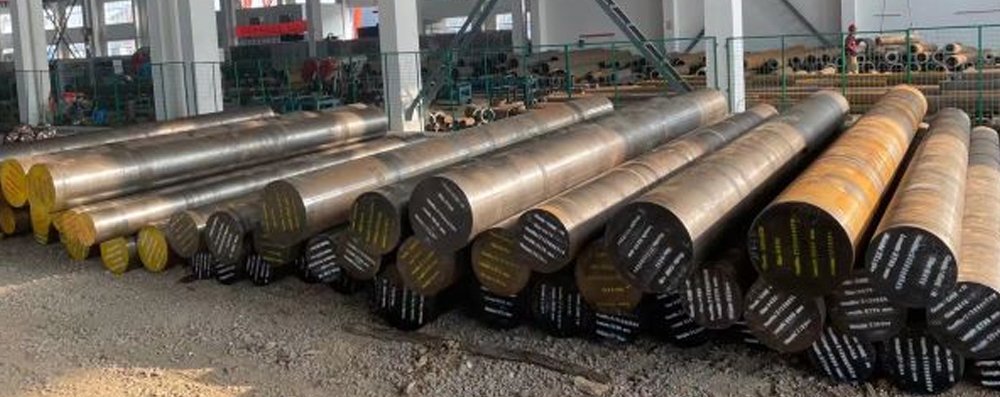Introduction
C55 Mn2 is a medium-carbon steel that offers excellent strength, wear resistance, and good machinability. The addition of manganese improves the strength and hardness of the steel, making it ideal for components that require high tensile strength and resistance to wear. C55 Mn2 is often used in applications where mechanical properties such as strength, toughness, and wear resistance are critical. The material can be heat-treated for enhanced mechanical performance, especially in heavy-duty or high-stress applications.
Uses/Applications of C55 Mn2 Grade:
C55 Mn2 is versatile and used in a wide variety of mechanical and industrial applications requiring high strength and durability.
- Automotive Industry: Ideal for producing components such as axles, shafts, gears, and crankshafts that require strength and resistance to wear.
- Mechanical Components: Suitable for producing heavy-duty parts such as pins, bushings, and bearings.
- Engineering: Used in manufacturing components exposed to stress, such as couplings, bolts, and brackets.
- Agricultural Machinery: Suitable for making gears, shafts, and other components that are exposed to abrasive conditions.
- Industrial Tools: Can be used for the production of tools and dies, where wear resistance and machinability are critical.
Properties of C55 Mn2 Grade:
- Medium-carbon steel with a moderate balance between strength, ductility, and wear resistance.
- Improved strength and hardness due to the addition of manganese.
- Excellent machinability when in an annealed or normalized state.
- Good toughness and moderate wear resistance in its natural state.
- Heat-treatable for increased hardness and strength.
- Moderate weldability in normalized or annealed conditions.
- Can be surface hardened to improve wear resistance for heavy-duty applications.
- Heavy-duty Engineering: Applied in producing components in industries that require durability and strength under heavy loads, such as in the manufacturing of turbines and heavy machinery parts.
Chemical Composition (Typical):
| Element | Content (%) |
| Carbon (C) | 0.52 – 0.60 |
| Manganese (Mn) | 1.20 – 1.60 |
| Silicon (Si) | 0.20 – 0.35 |
| Sulfur (S) | ≤ 0.05 |
| Phosphorus (P) | ≤ 0.05 |
| Iron (Fe) | Balance |
Mechanical Properties (Typical in Normalized Condition):
| Property | Value |
| Tensile Strength | 650 – 850 MPa |
| Yield Strength | 400 – 500 MPa |
| Elongation (in 50 mm) | 14% min |
| Impact Strength (Charpy V-notch) | 35 J min |
| Hardness (Brinell) | 180 – 250 HB |
| Hardness (After Hardening and Tempering) | 280 – 320 HB |
Physical Properties:
| Property | Value |
| Density | 7.85 g/cm³ |
| Modulus of Elasticity | ~210 GPa |
| Thermal Conductivity | ~50 W/m·K |
| Specific Heat Capacity | ~460 J/kg·K |
| Electrical Resistivity | ~0.17 µΩ·m |
Forging:
- Forging Temperature Range: 950°C – 1150°C.
- Optimal forging temperature is between 1050°C – 1100°C to achieve the best properties.
- After forging, slow cooling in air or controlled environments is recommended to prevent cracking and maintain material integrity.
Heat Treatment:
- Annealing: Heat to 750°C – 800°C, followed by slow cooling in the furnace. This softens the steel for easier machining and relieves internal stresses.
- Normalizing: Heat to 850°C – 880°C, and then allow air cooling to refine the grain structure and increase toughness.
- Hardening: Heat to 830°C – 860°C, then quench in oil or water to achieve higher hardness and tensile strength.
- Tempering: After hardening, temper at 550°C – 650°C to adjust the hardness and enhance toughness, particularly for parts subjected to high mechanical stress.
Dimensional Tolerances:
- Hot Rolled Bars: Standard tolerances are in accordance with BS 970 or equivalent specifications for medium-carbon steel.
- Cold Drawn Bars: Provide tighter dimensional tolerances, better surface finish, and enhanced mechanical properties.
- Forged Bars: Custom tolerances can be applied based on customer-specific requirements.
- Available Sizes: Ranges from small to large diameters and lengths to suit various industrial applications.
Machinability:
- Good machinability in the annealed or normalized condition.
- Can be machined effectively using standard tools such as high-speed steel (HSS) or carbide for precision cutting and shaping.
- Turning, drilling, milling, and boring are efficient with C55 Mn2 steel.
- Lubricants and coolants are recommended to reduce tool wear and improve the surface finish.
Corrosion Resistance:
- Moderate corrosion resistance: C55 Mn2 carbon steel is susceptible to rusting when exposed to moisture or harsh environments.
- Protective measures such as galvanizing, painting, or plating are recommended to prevent corrosion in outdoor or corrosive environments.
- Proper storage and handling are important to avoid corrosion during the manufacturing process.
Weldability:
- Moderate weldability when in normalized or annealed condition.
- Preheating to 150°C – 250°C is recommended for welding thicker sections, especially those larger than 25 mm.
- Use low-hydrogen electrodes and appropriate filler materials to ensure strong and reliable welds.
- Post-weld heat treatment is necessary to restore mechanical properties and reduce the risk of cracking in high-stress applications.
Available Form:
- Hot Rolled Bars
- Cold Drawn Bars
- Forged Bars
- Precision Ground Bars
- Custom Sizes: Available upon request.
- Standard Sizes: Available in a variety of diameters and lengths, customized to meet industrial requirements.
- Supplied in Normalized, Annealed, or Quenched and Tempered Conditions: Depending on the customer’s application needs.
Conclusion:
C55 Mn2 Carbon Steel is a versatile and durable material, offering a good balance of strength, toughness, and wear resistance. Its suitability for heat treatment and surface hardening makes it ideal for a wide range of industrial applications, including automotive, machinery, and engineering components. C55 Mn2 steel is commonly used for parts that are subjected to high-stress and abrasive conditions. While it has moderate corrosion resistance, appropriate protective coatings and handling can ensure long-term performance and reliability in demanding environments.
Related Products :20C8, ASTM A36, 20MN2, 55C8, 40C8, C45, ASTM SA-105, C50, C20, C55, EN3B, C55 Mn2, C60, C45, EN9, EN8, EN8D, IS 2062, EN43B, S355J2G3, S40C, SAE 1010, SAE 1018, ST52.3, 20MN2, Maps


